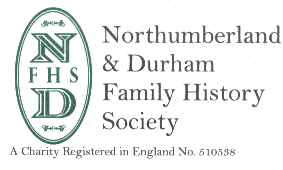 Reports
Reports

|
South Tyneside Meeting - April 2003"Ancestors in the Great War" by Peter DillarstoneA Report by Margaret Stafford |
Well, we've had our inaugural meeting at the Mission to Seafarers - most people spent some time reading the plaques on the wall and the atmosphere in the chapel seemed to match the topic of our talk tonight - tracing ancestors in the Great War. Our speaker commented that he, like so many others, had often passed by the Mission and wondered what lay inside - now we know! One point to bear in mind if you are coming to join us in future is that the room is quite cool so bring a jacket.
We welcomed some new faces tonight and hope to see them again. Our speaker was Peter Dillarstone and he took us through a pilgrimage - to some of the World War 1 cemeteries. Peter brought his Grandad's medals - something so many families must have, as well as the tin given to the troops at Xmas 1914 - tobacco and a pipe for smokers, pad and pencil for non smokers.
He pointed out that it is only 7 hours drive to go through the tunnel from Sunderland to France and reach the battlefields of the Western Front. The front for the British Expeditionary Force itself was only 80 miles long - little more than an hour's drive today, the road flanked on either side by monuments and cemeteries - a moving experience.
In August 1914 the force consisted of 700,00 men, by 1917 there were 7 million. The war was also a period of vast technological change, from the beginning where the Duke of Wellington would not have felt out of place, to the end where tanks and machines dominated.
Winters were the quietest months as the weather prevented much movement and yet in Feb 1917 still 5,835 men were casualties. 5 tonnes a week of unexploded gas shells are still found and dealt with and the Belgian army apparently has a 3 year backlog to deal with, cap badges and other reminders of the war regularly turn up.
The slides of the trenches - clean, with cement bags rather than sand bags and sheep peacefully grazing seemed rather incongruous but gave an idea of the environment the men had to survive in, in one area there are 20 miles of tunnels built by the Canadians and guided tours are available in the summer months.
Peter described how he had been drawn in to following up one particular soldier who (to his knowledge) is no relation. A friend picked up a photo, postcard home, death medal and accompanying citation of a John Barton in a Cullercoats junk shop. The little pile, separated from any family member to cherish, looked rather a sad sight but came alive as Peter explained how he had traced John to the 1881 census, age 2 months, living with family in Willington, his father was a coalminer hailing from Blackburn.
By 1901 John was a 19 year old elementary school teacher in Normanby living in Albion St Middlesbrough and here is the spooky bit - Peter has discovered his wife's family was living in the same street at the same time so John could have taught them!!
John died on 2 Nov 1916 age 35, just months after the photo Peter had bought had been taken. He was in the London Regiment and we know he was married and had a daughter called Rene (the postcard home is to her) but here the story ends so far but Peter would be delighted to hear from anyone who thinks they can add to this slim family history.
In a fitting touch, one of Peter's slides was of the grave of John Barton.
If you are looking for information about an ancestor lost in the Great War Peter recommends the Commonwealth War Graves Commission website. There is also a Western Front Association website as well as a 1914-18 war group. Records are of course in the PRO at Kew - those which survived the Blitz. There are also unit war diaries which detail day to day movement but have little info about the individual soldier.
All in all we had an enjoyable and often poignant evening and the setting seemed quite fitting.
If anyone thinks they may have further information about John Barton please let me know and I will pass the information on to Peter.